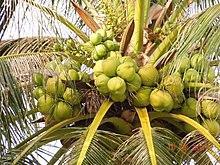
5 minute read
Cocos nucifera (Coconut
from PNGAF MAGAZINE ISSUE # 9D4B1 of 31 May 2022. Why Certain Planation Species in PNG?
by rbmccarthy
The coconut tree (Cocos nucifera) is a member of the palm tree family Arecaceae) and the only living species of the genus Cocos. [ The term "coconut" (or the archaic "cocoanut") can refer to the whole coconut palm, the seed, or the fruit, which botanically is a drupe, not a nut. The name comes from the old Portuguese word coco, meaning "head" or "skull", after the three indentations on the coconut shell that resemble facial features The coconut tree provides food, fuel, cosmetics, folk medicine and building materials, among many other uses. The inner flesh of the mature seed, as well as the coconut milk extracted from it, form a regular part of the diets of many people in the tropics. Mature, ripe coconuts can be used as edible seeds, or processed for oil and plant milk from the flesh, charcoal from the hard shell, and coir from the fibrous husk. Dried coconut flesh is called copra.
Source Wikipedia.
Advertisement
Coconuts were first domesticated by the Austronesian peoples in Island Southeast Asia and were spread during the Neolithic via their seaborne migrations as far east as the Pacific Islands, and as far west as Madagascar and the Comoros. They played a critical role in the long sea voyages of Austronesians by providing a portable source of food and water, as well as providing building materials for Austronesian outrigger boats. The evolutionary origin of the coconut is under dispute, with theories stating that it may have evolved in Asia, South America, or on Pacific islands. Trees grow up to 30 m (100 ft) tall and can yield up to 75 fruits per year, though fewer than 30 is more typical. About 75% of the world's supply of coconuts is produced by Indonesia, the Philippines and India combined. Coconuts PNG. Copra plantations in New Guinea have been cultivated since the late 19th century, originally by German colonialists. They were continued by Australian interests following World War 2. Copra is the fourth most significant agriculture cash crop of PNG. An estimated 2.6 million people are engaged in coconut activities in PNG to either generate income (copra for soap manufacture and later margarine production) and/or as food to supplement their livelihoods.
In 1884, German settlers arrived in eastern New Guinea who planted coconut palms (Cocos nucifera) to produce copra, the dried flesh of the coconut. They established the colony of German New Guinea. To counter the growing German presence in the region, the Australian state of Queensland established the Territory of Papua as a de facto possession covering approximately the southeast third of the island. Both the Queensland and German plantations thrived, providing opulent living conditions for the expatriates. Grand mansions were built on the plantations, complete with luxury furnishings. Much of the labour was performed by New Guinea natives. At the start of the First World War in 1914, Australia sent a small military force to take over the German possessions in the South Pacific. Two Germans were killed in the process, while

the remaining German plantation owners were initially sent back to work on their plantations. The 1919 Treaty of Versailles saw Germany lose all its overseas possessions, including German New Guinea, which became the Territory of New Guinea , a league of Nations mandate Territory under Australian administration. The property of German planters was expropriated in the 1920s, and the coconut plantations were offered for sale to returning soldiers, many financed by the large trading companies which would manage the plantations. By the 1980s, copra production in New Guinea was dominated by two Australian trading companies: Burns Philp and W R Carpenter & Co. In 1985 the PNG government established the Copra Marketing Board, to take over copra production in PNG. The Board saw the virtual decimation of the copra industry in PNG, which was ruined by American soybeans in the late 1980s. Copra exports fell to negligible levels by 2004. According to the PNG Central Bank, the PNG’s copra exports in 2003 were 3,600 tons, levels at which copra exports could be said to be close to extinction. Exports rose to more than 9,100 tons in 2004. In 1993, Kokonas Industri Koporasen (KIK) built a copra mill in Madang and effectively gained monopoly control over the marketing of PNG copra. In 2003 the government ended KIK’s monopoly powers over marketing. A year later KIK suffered losses that forced the group to call in liquidator, PNG Coconut Commodities, Rex Paki, who in April 2004, sold the Madang mill to Australian-owned Coconut Oil Production Madang Ltd (COPM, owned by Donald Brownlie Fleming) for K7.8 million (US$2.4 million).
The country’s only other coconut mill is owned by the Carpenter Group located in Rabaul.
Aerial View Robinson River Coconut Plantation.
Photo credit Dick McCarthy 2005. R
obinson River plantation Abau was one of the biggest coconut plantations in Papua comprising some 3,400 acres of plantation producing some 1000 tons of copra annually. There were regular DC3 loads of beef to Port Moresby. There were over 20 miles (31 kms) of railway lines throughout the plantations for transport of coconuts to a central copra drier. During World War 2, the Australian Army removed the railway lines. It was purchased by Burns Philip in 1936. It had been originally developed and managed for the Horn family by BNGD17 .

17 McKillop R F & Pearson M 1977.End of the Line. A History of Railways in PNG. ISBN 998084096x UPNG Press.
Lewis DC 1996. The Plantation Dream. ANU Press. ISBN 0959547789

Trasporting copra to jetty in 1936.
Source PNG National Archives.
Abandoned Jetty.
Photo credit Dick McCarthy 2005.
Abandoned plantation buildings. Abandoned airport terminal and overgrown airstrip. Photo credit Dick McCarthy 2005.
Source PNGRIS.













